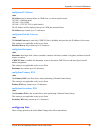
Appendix A: Command Reference
xPico® Wi-Fi® Embedded Device Server User Guide 75
An empty or missing <value> element in each present <configgroup> clears the
setting to its default.
Quick Tour of XML Syntax
Declaration
The first line, <?xml version="1.0" standalone="yes"?>, is called the XML declaration.
It is required and indicates the XML version in use (normally version 1.0). The remainder of the file
consists of nested XML elements, some of which have attributes and content.
Element Start and End Tags
An element typically consists of two tags: start tag and an end tag that surrounds text and other
elements (element content). The start tag consists of a name surrounded by angle brackets, for
example <configrecord>. The end tag consists of the same name surrounded by angle
brackets, but with a forward slash preceding the name, for example </configrecord>. The
element content can also contain other "child" elements.
Element Attributes
The XML element attributes that are name-value pairs included in the start tag after the element
name. The values must always be quoted, using single or double quotes. Each attribute name
should appear only once in an element.
Figure A-4 shows an XML example which consists of a declaration (first line), nested elements
with attributes and content.
Figure A-4 XML Example
<configgroup name = "HTTP Server">
<configitem name = "State">
<value>Enabled</value>
</configitem>
<configitem name = "Port">
<value>80</value>
</configitem>
<configitem name = "Inactivity Timeout">
<value>5 minutes</value>
</configitem>
<configitem name = "Access Control" instance = "1">
<value name = "URI">/</value>
<value name = "AuthType">Basic</value>
<value name = "Users">admin</value>
</configitem>
</configgroup>
The xPico Wi-Fi embedded device server uses the attributes in the following subsections to label
the group configuration settings.


















